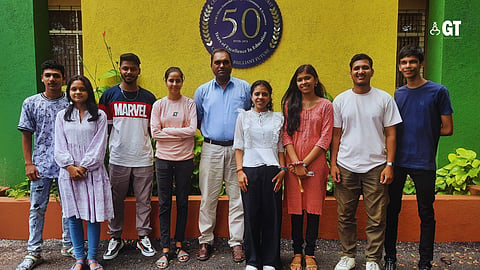

To redefine graphic design, one needs to embrace emerging technologies like AI, machine learning, AR, VR, 3D printing and prototyping. One also needs to foster a creative vision through cross-disciplinary collaboration, user-centred design, storytelling, sustainability and inclusive design. One has to stay updated with market trends, develop an entrepreneurial mindset and build a strong professional network.
One should also utilise AI tools for design variations, analyse user behaviour data and create personalised designs. Incorporating storytelling elements into designs to enhance user engagement and brand loyalty is also a requirement. Considering eco-friendly practices and materials and creating designs accessible to everyone are steps to redefine graphic design with technology.
Having said that, under the direction of their professor, a group of forward-thinking college students have integrated Artificial Intelligence (AI) into their semester-end graphic design project, a spectacular merger of technology and artistic expression. And the outcome? An amazing demonstration of the countless opportunities that arise when machine learning is combined with human ingenuity.
Renowned for his creative teaching approaches, assistant professor Sandesh Gaundalkar challenged his B.Voc. Software Technology students at Shree Damodar College of Commerce & Economics, Margao, to investigate the unexplored field of artificial intelligence in graphic design for their project. The challenge was enthusiastically accepted by the students, who saw it as a chance to explore the limits of their imagination.
Sam Steward Miranda said, “I felt both excited and curious. The idea of integrating AI into our magazine design was intriguing, though I wondered how it would merge with art and creativity.”
As part of the project, students had to use AI technologies like Generative Adversarial Networks (GANs) and automated image recognition to build a magazine about the application of AI in several areas, including education, marketing, healthcare, agriculture, and defence.
Nester Fernandes said, “Our project involved using AI tools like neural style transfer, and smart image recognition to design magazine layouts. Our professor provided instructions on incorporating these AI tools while preserving our unique artistic styles.”
Hema Parab said, “Working with AI was enlightening, it was like having a digital design partner. AI-generated initial designs based on datasets of modern layouts and our task was to infuse our creativity into them.”
The outcome was nothing short of remarkable. The striking visuals the students produced for magazine covers and page layouts skilfully combined their distinct artistic sensibilities with the accuracy of AI algorithms. With the use of AI, quick prototyping and testing were possible, allowing students to quickly investigate a variety of design ideas.
Purva Kamat said, “What impressed me the most was AI’s speed and adaptability. We could swiftly experiment with different design concepts, broadening our creative horizons. It wasn’t about AI replacing us; it was about AI enhancing our abilities.”
Sanjivy agreed to this and added, “This project ignited discussions among students. We realised that AI isn’t meant to replace artists; it’s meant to complement and inspire us. It’s a tool that enables us to explore design possibilities we might not have otherwise considered.”
The teacher Gaundalkar believes that incorporating AI into education will prepare students for the future job market, where AI-driven tools are becoming increasingly prevalent. He emphasised, “We need to equip the next generation with the skills to collaborate effectively with AI systems.”
This project has ignited a lively debate about the place of technology in the creative process and showed off AI’s potential in the graphic design industry. This small step could become a new benchmark for graphic design education, proving that incredible things happen when creativity and cutting-edge technology come together.
Bhakti Mirashi said, “Our project has demonstrated that when creativity intersects with technology, the possibilities are boundless. It has been an inspiring journey, and I eagerly anticipate AI’s future impact on the world of graphic design.”
While being thankful for such a great invention of humankind, Tanay Naik said, “As we conclude this semester, I have a deep appreciation for AI’s role in graphic design. It’s more than just a tool, it’s a creative ally. Professor Gaundalkar’s forward-thinking approach to integrating AI into our education has equipped us with valuable skills for the evolving job market."
Now the onus lies on the students to continuously learn and develop skills through online courses, experimentation and business integration. And then network with fellow designers and potential clients to expand one’s professional network. By combining technology, creativity, and sustainability, one can redefine graphic design in a way that is both innovative and impactful.